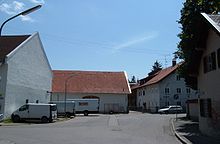Englschalking
Englschalking is a district of the Bavarian capital Munich and belongs to the city district 13 Bogenhausen .
location
Englschalking is relatively centrally located in the Bogenhausen district. The historic town center is northeast of the intersection of Englschalkinger Strasse and Ostpreußenstrasse. In the east, Englschalking has developed beyond the Munich East – Munich Airport railway line to Max-Nadler-Strasse, in the south it is bordered by the Memeler and Englschalkinger Strasse, in the west by Cosimastrasse and the area of the former Prinz-Eugen-Strasse. Barracks and to the north of Fideliostraße.
history
In the area of Stegmühlstraße / Rambaldistraße, excavations carried out by the Bavarian State Office for Monument Preservation in 1983 discovered End Stone Age burials and an early Bronze Age burial ground. On the northern edge of Englschalking, south of Stegmühlstrasse and east of the S-Bahn, there was a settlement from the early Middle Ages excavated in 1983 with a house, iron smelter, well, barn, stables and a court cemetery in which 34 burials are documented. Jewelry finds allow a date to the 7th century AD. Englschalking is believed to have been founded in the 9th or 10th century. Englschalking was first mentioned in a document in 1231/1234 in the Bavarian Duke Surbar. The name is derived from Engelschalch (strict servant) or English alcho (also Engilschalko ). In 1319 the hamlet of Englschaling was sold by Duke Ludwig to the Hochstift Freising , to which it belonged until secularization in 1803 as part of the County of Ismaning . When the community was formed in Bavaria in 1818 , Englschalking became part of the community of Daglfing .
Most of the current development in the historic town center dates from the end of the 19th century, when Englschalking achieved some prosperity through the cultivation of moss and through brick factories in which bricks were baked from the clay obtained here for the brisk building activity in Munich was.
Englschalking developed into the central location of the Daglfing community at the beginning of the 20th century, partly because a community school was opened in 1896 on what is now Schnorr-von-Carolsfeld-Strasse. With the community of Daglfing, Englschalking was incorporated into the city of Munich on January 1, 1930.
Townscape
The historic center of Englschalking is a good example of a clustered village . Large courtyards stand in an irregular arrangement around the 13th century church of St. Nicholas . This town center, which is a listed building ensemble, has roughly the same size as the village in the early 19th century.
South of the town center and Englschalkinger Strasse is the large primary school building on Ostpreußenstrasse, a work by Hermann Leitenstorfer from the 1930s. The original village school on the eastern edge of the old town center , built in the 19th century as a community school for the community of Daglfing , now serves as a kindergarten. The parish church of St. Emmeram is also located on Ostpreußenstrasse .
To the west of the town center is Fideliopark, built between 1966 and 1970 with three to nineteen-story apartment blocks, and further west is Cosimapark, built between 1964 and 1969, with four-story apartment blocks and ten to nineteen-story high-rise buildings surrounded by balconies. Extensive single-family housing estates and settlements with multi-family houses (such as the Barlowstrasse housing estate ) have been built on both sides of the railway line since 1978 .
traffic
The Munich East – Munich Airport railway runs through Englschalking and is served every 20 minutes by the S8 line of the Munich S-Bahn from Herrsching to Munich Airport. This is where the double-track Munich-Englschalking S-Bahn station , equipped with side platforms , is located .
The tram route to St. Emmeram, opened in 2011, affects Englschalking along Cosimastraße. It is currently on line 16 with connections to Bogenhausen (Arabellapark, Effnerplatz , Herkomerplatz, Ismaninger Straße), to Haidhausen ( Klinikum right der Isar , Max-Weber-Platz, Wiener Platz, Gasteig, Müllersches Volksbad ) and the city center.
The subway line U4 from the city center does not quite reach Englschalking, but it is well connected with three bus lines and one tram line to the final stop Arabellapark .
There are plans to extend underground line 4 from the current Arabellapark terminus via Fideliopark to the Englschalking S-Bahn station , which would shorten the travel time between Bogenhausen and Munich Airport by a few minutes. However, critics are skeptical about an extension of the rather underutilized U4. Part of the calculated increase in passenger numbers has already been taken up by the new tram line, so that the extension of the subway is currently postponed.
Education and culture
- Ecological education center of the Munich Adult Education Center and the Munich Environment Center, Englschalkinger Str. 166
Individual evidence
- ^ Herbert Feldmann / Roland Krack: The sunken village . In: Willibald Karl (Ed.): Villages on the brick country. Munich 2002: Buchendorfer Verlag, p. 9
- ↑ Herbert Feldmann / Roland Krack: Pre- and early history . In: Willibald Karl (Ed.) Dörfer auf dem Ziegelland (literature), p. 14 f.
- ^ Karin Ernst: Medieval village centers and churches . In: Willibald Karl (Ed.) Dörfer auf dem Ziegelland (literature), p. 27
- ^ Wilhelm Volkert (ed.): Handbook of Bavarian offices, communities and courts 1799–1980 . CH Beck, Munich 1983, ISBN 3-406-09669-7 , p. 601 .
- ^ Fritz Lutz : Daglfing, Denning, Englschalking, Johanneskirchen. 50 years near Munich (1930-1980) , Munich 1982, p. 34
- ↑ St. Emmeram tramway (PDF)
literature
- Willibald Karl (Ed.): Villages on the brick land . Daglfing-Denning-Englschalking-Johanneskirchen-Zamdorf. Buchendorfer, Munich 2002, ISBN 978-3-934036-90-1 .
Web links
- Englschalking on the website of the Association for District Culture in the Munich Northeast eV
- Plan of the early medieval settlement
Coordinates: 48 ° 9 ' N , 11 ° 39' E




